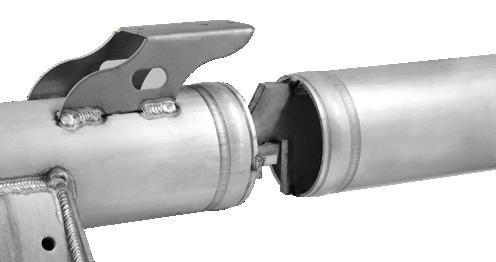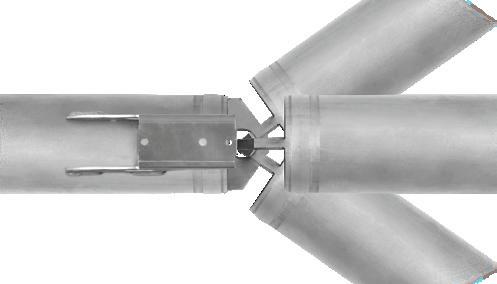
2 minute read
FLEX JOINT HOOK & RECEIVER
INNOVATIVE DESIGN ////////////////////////////
Page 14
The flex joint hook and receiver is another Reinke engineering innovation, which highlights the care we put into designing our systems. The hook and receiver is a pipe joint that allows our irrigation systems to traverse hilly terrain with minimal impact to water flow.
The flex joint hook and receiver is located where the water pipe meets the tower. Our unique joint provides unparalleled rotational movement and flexibility.
Side view, rotational movement


The joint is located inside the pipe and covered by an external, flexible boot that is backed by a 10-year warranty. Why did we place the joint at the center of the pipe when our competitors use an external ball-hitch coupler? Well, it’s really just a simple matter of physics; the most efficient place to rotate within a cylinder is directly in the center. The central joint allows the pipe to remain aligned with flex or rotation. Because the pipe remains aligned, the boot is not excessively stretched, which enhances the joint’s overall longevity. Side view, up-and-down movement Top view, side-to-side movement
By using materials science and current technology, we can build a better product and therefore create a better future.”
— Cody Bailey, Director of Engineering
INTERNAL FLEX JOINT
The tables illustrate that the Reinke internal flex joint has less friction loss at a real application slope of 15° as compared to an external ball-hitch coupler.
1.75 REINKE INTERNAL FLEX JOINT 1.50 1.25 1.00 .75 .50 .25 .125 0
500 600 700 800 900 1000 1100 1200 1300 FLOW RATE IN GPM PRESSURE DROP PER JOINT
1.75 EXTERNAL BALL-HITCH COUPLER 1.50 1.25 1.00 .75 .50 .25 .125 0
500 600 700 800 900 1000 1100 1200 1300 PRESSURE DROP PER JOINT
Aligned 15° Slope Simulation
*Study performed by Clemson University
The proof is in the data. If you have inclined or bumpy terrain, you know how challenging it can be to attain even water application throughout the area. Clemson University tested the Reinke internal flex joint against a competitor’s external ball-hitch coupler. Researchers tested both joints at alignment (flat) and at a 15-degree slope with flow rates ranging from 500 to 1,300 gallons per minute (GPM).
At a flow rate of 1,300 GPM with a 15-degree slope, the external ballhitch coupler experienced a pressure drop per joint of 1.75, while the Reinke internal flex joint was less than 0.5. The incline pressure drop also was more significant for the external ball-hitch coupler at lower flow rates.
Basically, the flex joint hook and receiver allows Reinke systems to irrigate where other systems can’t. Ask your dealer about the X-treme package for irrigation on steeper slopes.








